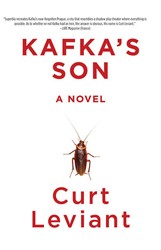In 2024, one hundred years after he was buried at the age forty in the Jewish cemetery outside Prague, Franz Kafka continues to haunt us. His stories and parables of estrangement and bureaucratic nightmare remain an uncanny mirror of our own bewildering, psychologically dislodging time.
In Life After Kafka, novelist Magdaléna Platzová focuses on perhaps the most enigmatic figure in Kafka’s biography: a young woman by the name of Felice Bauer, with whom the twenty-eight-year-old Kafka became infatuated at a dinner in August 1912. Kafka was immediately taken with Felice, a lively and compassionate young woman from a bourgeois Jewish family from Berlin. He eventually wrote over five hundred letters and postcards to her during an intense five-year correspondence that began that September.
Over the course of their fraught epistolary relationship, Kafka and Felice were twice engaged and twice estranged; apparently, they enjoyed a non-platonic, ten-day sojourn (in between engagements) in the summer of 1916. Kafka’s biographers tend to interpret this charged interlude with Felice as crucial for his own creative development. Just two days after they met, Kafka composed his breakthrough story, “The Judgment” — a chilling, intimate work of filial angst and paternal accusation — and later, he was inspired to draft the early chapters of the novel Amerika, which was published posthumously in 1927.
Kafka and Felice’s romantic fate, however, proved doomed. Reviewing their correspondence, published in English in 1973 as Letters to Felice, the late critic Morris Dickstein observed, “Kafka never allowed himself to respond to Felice as a full human being.”
“Who really was Felice Bauer?” Platzová asks. Her novel seeks to answer that question by imagining the psychological impact of the thwarted Kafka-Felice romance on Felice’s life. In a series of chapters, Platzová traces Felice’s journey from European cities in the 1930s to Los Angeles in the 1940s, when she fled the Nazis and took with her some painful memories of Kafka.
Intriguingly, Platzová inserts herself in various chapters as an actor, recounting her interviews with Felice’s son and granddaughter. Thus Life After Kafka moves contrapuntally, back and forth in time and place, as Platzová searches for the meaning and impact of Kafka’s shadow on the still-living.
Platzová portrays Felice as a devoted wife, mother, and shrewd entrepreneur (a manicurist and sought-after baker) who experiences freedom in America. Felice emerges as a fascinating figure, the guardian of a painful, intimate history that was hidden in a shoebox for decades, tucked away with hundreds of Kafka’s letters. Life After Kafka aims, in a gesture of profound compassion, to rescue Felice from what Platzová’s Felice calls “the poison of those letters.”
The figure of “Kafka” remains, in the end, a ghostly presence. Even Platzová can’t seem to shake his hovering spirit, which presides over the entire novel. On some level, she identifies with her subject, projecting her own “dislocated, transplanted self” onto Felice and giving Kafka’s twice-spurned, would-be fiancée a voice. Life After Kafka is, in this respect, Platzová’s own sequence of love “letters to Felice”: a remarkable act of fictional recuperation that enables a new generation of Kafka-obsessed readers to feel Felice’s presence yet again.
Donald Weber writes about Jewish American literature and popular culture. He divides his time between Brooklyn and Mohegan Lake, NY.




